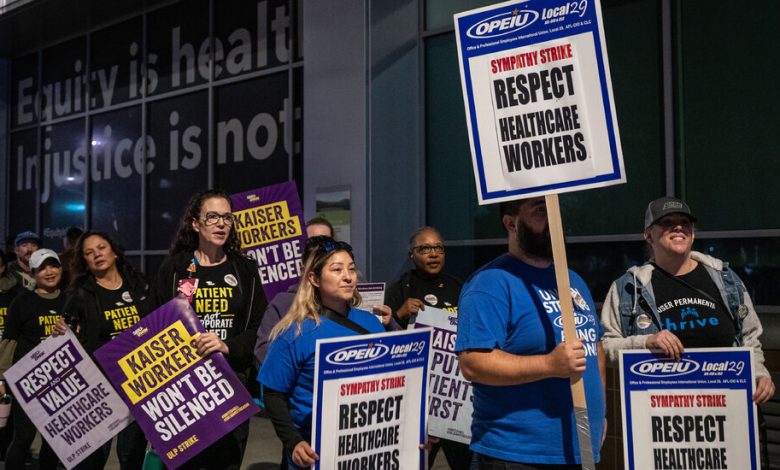Kaiser Permanente Workers Near End of Strike Without a Deal

Kaiser Permanente health care workers were finishing a three-day strike on Friday, and were expected to return to work early Saturday morning without a new contract.
No new negotiation sessions were scheduled until Thursday, Oct. 12, and Friday, Oct. 13. Union officials warned another walkout was possible. The two sides had not yet come to an agreement on several key issues, including wage increases.
“Outsourcing of critical health care duties has become a key sticking point in negotiations in recent days, as Kaiser executives have refused to put limitations on subcontracting and outsourcing, which keep experienced health care workers in jobs and provide strong continuity of care for patients,” the union officials said in a statement.
The effects of the three-day strike, which included X-ray technicians, receptionists, medical assistants and sanitation workers, were immediately apparent. Kaiser brought in thousands of outside workers to keep its hospitals, emergency departments and urgent care centers open, but a spokeswoman said the organization had been forced to reschedule some appointments and procedures, including surgeries not considered urgent.
On Friday, more than half of Kaiser’s 106 laboratories in Southern California were closed, according to the company’s website. In Oregon and Washington, almost two dozen Kaiser medical offices were also closed, and another 11 facilities that were still operating had temporarily shuttered various departments. Kaiser encouraged patients to use mail-order pharmacy services instead of picking up prescriptions in person and suggested that patients conduct virtual visits rather than appear at offices.
The acting head of the U.S. Department of Labor, Julie A. Su, met with officials from both sides of the negotiations this week and plans to be present when talks resume on Thursday, the agency said.
The stalemate occurred during a time of labor unrest nationwide. The tight labor market has emboldened many unions, causing a ripple of labor action across various industries. A Hollywood actor strike, autoworker picket lines and a threatened (but averted) United Parcel Service walkout, all within the last three months, indicate a cultural shift with no signs of slowing down.
Across the country, health workers have voiced frustration with working conditions and pay, pointing to burnout and excruciating staffing shortages that were exacerbated by the pandemic. More than a dozen health worker strikes have taken place this year in New York City, California, Illinois, Michigan and elsewhere.
The Coalition of Kaiser Permanente Unions, a collection of about a dozen unions, represents about half of Kaiser’s unionized work force and more than 75,000 workers who walked off the job. Its largest member union is S.E.I.U.-United Healthcare Workers, which has been active in labor disputes in California with other hospital systems like HCA Healthcare and Tenet Healthcare. The union recently authorized a possible strike at 11 Tenet hospitals.
For Kaiser Permanente, whose health plans cover 13 million people in eight states, the labor action represented a turning point in what has historically been a relatively amicable relationship with employees.
Edith Hurtado, a medical assistant at a Kaiser clinic in San Francisco, said that she went on strike because her job was “getting exhausting,” and that patients were waiting longer for care because her clinic was so short-staffed.
The unions say they are fighting for more than higher wages and want Kaiser Permanente to address dangerously low levels of staffing at its hospitals and clinics. Unions across the country have pushed for improved conditions, including higher staffing levels and better protective equipment against the pandemic.
Research shows that health care unions’ fight to improve working conditions for their members often increases quality of care, said Adam Dean, an associate professor of political science at George Washington University who has studied the impact of unions on nursing homes. “There is very clear spillover effects for patients,” he said.
The strike is also about the rising cost of living. The group of unions represents clerical and maintenance workers, many of whom have been particularly hard hit and are struggling financially. Many are enraged by the million-dollar salaries of Kaiser executives.
“The lower-wage workers are finding they are falling behind,” said John August, who was the executive director for the coalition of Kaiser unions until 2013 and is now a program director at Cornell’s School of Industrial and Labor Relations.
Timothy Regan, a clinical health educator for 25 years, was among the sea of protesters, clad in purple and yellow, who had flooded the sidewalks and medians in San Francisco on Wednesday, cheering and rattling tambourines.
“We want that collaborative good-faith partnership, and we wanted it months ago,” Mr. Regan said, adding that he wanted to ensure good working conditions for the next generation. “Many of us are surprised actually that it got to this point.”
Soumya Karlamangla contributed reporting.




